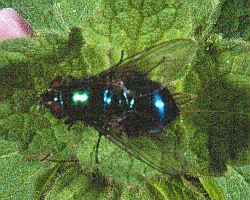Cluster Flies, Face Flies, and Blow Flies in Homes
ENTFACT-624: Cluster Flies, Face Flies, & Blow Flies in Homes | Download PDF
by Mike Potter, Extension Entomologist
University of Kentucky College of Agriculture
Homeowners are often bothered by the appearance of sluggish flies in their homes in late winter and early spring. These flies are not breeding in the home and constitute no health hazard. However, they are a nuisance and should be controlled. These flies are collectively called "clustering flies" but may actually be any of three groups or types of flies discussed below.
Cluster Flies Pollenia rudis
These insects, sometimes called "attic flies", often become pests in homes. They usually appear in late fall or early winter and again on warm, sunny days in early spring. They buzz around the home and gather in large numbers at windows, often in rooms that are not regularly used.
The cluster fly is a little larger than the common housefly and moves sluggishly. It can be recognized by the short, golden colored hairs on its thorax, the part of the body to which the legs and wings are attached. The larvae, or maggots, of cluster flies develop as parasites in the bodies of earthworms.
The adult flies emerge in late summer and early fall and seek protected places to spend the winter. In many cases, this is within the walls, attics and basements of homes. Window screens offer no protection from the flies because they crawl in the home through small openings in the walls of the building. These same overwintering flies get into rooms during the winter and spring months entering through window pulley holes, around the baseboards and through other small openings in walls.

Face Flies
Face Flies Musca autumnalis
Face flies are serious pests of cattle and may overwinter in homes or invade them during the summer. They closely resemble the common housefly, and only an expert can tell them apart. Overwintering face flies have habits similar to cluster flies and control procedures are similar.
Face flies are most likely to invade farm homes or homes located near pastures or where cattle are kept since the larvae develop in fresh cattle manure. During the summer, the adults feed on the mucous secretions from the eyes and noses of cattle and horses.
Blow Flies Phormia sp; Lucilia sp.
Blue or green bottle flies are robust flies with shiny metallic bodies that can often be found in homes during winter and early spring. These insects develop in manure or carrion and are usually apparent in small numbers. However, they are strong fliers and are attracted to lamps or lights. Their "buzzing" flight is very annoying.

Blow Fly
Control Procedures
Cluster flies, face flies and blow flies are difficult to control once they have gained access to homes because they hibernate in wall voids and other inaccessible places. The procedures listed here are the best available but may not insure complete elimination of the insects.
- Close and seal as many openings as possible through which the flies can enter. This procedure is time consuming and may require a dedicated long term effort.
- Use a 2- or 3-gallon compressed air sprayer to apply a 0.5% diazinon or 3% malathion residual spray to surfaces in attics, basements, closets, store rooms and other areas where the flies congregate. These sprays also are effective if applied to the outside of the house in the fall when the flies collect in these areas before entering the home. Pay special attention to the areas beneath the eaves and around the windows and other areas where flies are likely to seek entry.
- Inject diazinon or bendiocarb dust into window pulley openings and, wherever possible, into wall voids and other confined spaces where the flies may be hibernating. A diazinon spray or dust may also be used for longer residual action. Observe label precautions.
- To kill the flies that buzz about rooms, use a synergized pyrethrins spray or aerosol. You will obtain best results with pyrethrins if the room is closed and the spray or aerosol is misted into the air. Pyrethrins are "quick kill" insecticides and have little or residual action. These sluggish flies can also be eliminated as they appear with mechanical control methods such as fly swatters or vacuum sweepers.
Revised: 1/94
CAUTION! Pesticide recommendations in this publication are registered for use in Kentucky, USA ONLY! The use of some products may not be legal in your state or country. Please check with your local county agent or regulatory official before using any pesticide mentioned in this publication.
Of course, ALWAYS READ AND FOLLOW LABEL DIRECTIONS FOR SAFE USE OF ANY PESTICIDE!
Blow fly photo: R. Bessin, University of Kentucky Entomology. Face fly photo: University of Florida
